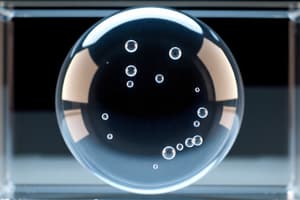Podcast
Questions and Answers
What did Henry Moseley state in the modern periodic law?
What did Henry Moseley state in the modern periodic law?
What is the definition of valency?
What is the definition of valency?
How many periods does the modern periodic table have?
How many periods does the modern periodic table have?
Why do Group 1 elements have valency 1?
Why do Group 1 elements have valency 1?
Signup and view all the answers
What determines the valency of an element?
What determines the valency of an element?
Signup and view all the answers
What is a periodic table?
What is a periodic table?
Signup and view all the answers
In the periodic table, what are the horizontal rows known as?
In the periodic table, what are the horizontal rows known as?
Signup and view all the answers
What is the reason for periodicity in the periodic table?
What is the reason for periodicity in the periodic table?
Signup and view all the answers
How does the number of valence electrons change as you move from left to right across a period in the periodic table?
How does the number of valence electrons change as you move from left to right across a period in the periodic table?
Signup and view all the answers
Which statement about elements in the same group is correct?
Which statement about elements in the same group is correct?
Signup and view all the answers
Name two elements classified as halogens in the periodic table.
Name two elements classified as halogens in the periodic table.
Signup and view all the answers
Which elements are placed at the extreme right of the periodic table?
Which elements are placed at the extreme right of the periodic table?
Signup and view all the answers
Which type of elements have their outermost shell complete?
Which type of elements have their outermost shell complete?
Signup and view all the answers
Which element has two outermost shells incomplete?
Which element has two outermost shells incomplete?
Signup and view all the answers
What is the valency of elements in Group 1?
What is the valency of elements in Group 1?
Signup and view all the answers
Study Notes
Periodic Table and Valency
- Henry Moseley stated that the elements should be arranged in a periodic table according to their atomic numbers.
- Definition of valency: The number of electrons an element can lose or gain to form a bond with another atom.
- The modern periodic table has 7 periods.
Valency and Groups
- Group 1 elements have valency 1 because they can lose one electron to form a bond with another atom.
- The valency of an element is determined by the number of electrons it can lose or gain to form a bond with another atom.
- Elements in the same group have the same valency because they have the same number of electrons in their outermost shell.
Periodic Table Structure
- A periodic table is a tabular arrangement of elements according to their atomic numbers, electron configurations, and recurring chemical properties.
- The horizontal rows in the periodic table are known as periods.
- The reason for periodicity in the periodic table is the recurring pattern of similar chemical properties in elements due to the same number of electrons in their outermost shell.
Electronic Configuration
- As you move from left to right across a period in the periodic table, the number of valence electrons increases by one in each element.
- Elements in the same group have the same number of electrons in their outermost shell.
Element Classification
- Halogens are elements classified as Group 17 in the periodic table, and two examples are Fluorine (F) and Chlorine (Cl).
- Elements placed at the extreme right of the periodic table are Noble Gases.
- Noble Gases have their outermost shell complete.
- Carbon is an element that has two outermost shells incomplete.
- The valency of elements in Group 1 is 1.
Studying That Suits You
Use AI to generate personalized quizzes and flashcards to suit your learning preferences.
Description
Test your understanding of Periodic Table concepts with this question from Class X Chemistry Chapter 1. The question covers the modern periodic law and the structure of the periodic table.




